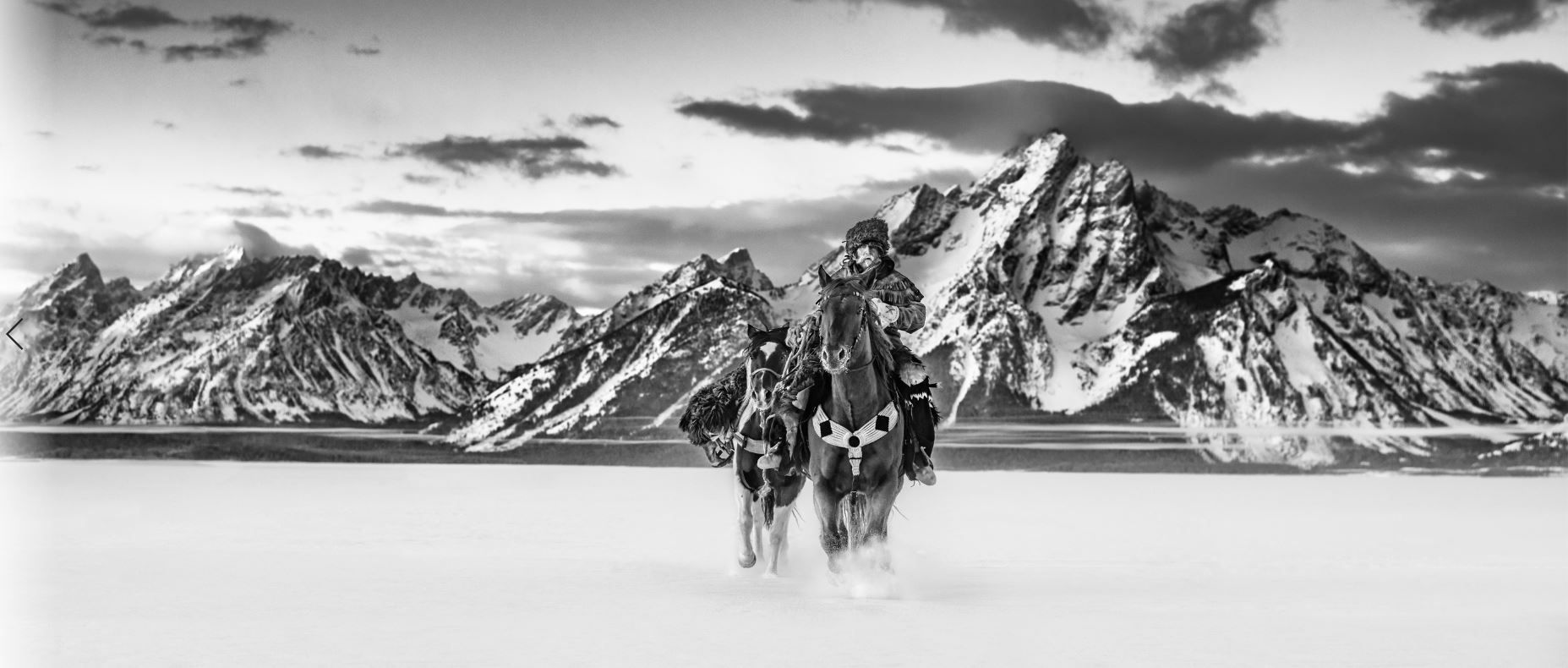Apr. 7th, 2021
David Yarrow was born in Glasgow, Scotland in 1966. He began his photographic career early, as a 20-year-old photographer for The London Times at the World Cup Final in Mexico City. On that day, Mr. Yarrow took a famous image of Diego Maradona holding the World Cup and, as a result, was subsequently asked to cover the Olympics and numerous other major world sporting events. Years later, he established himself as a fine art photographer by documenting the natural world from new, dynamic perspectives.
Mr. Yarrow’s evocative and immersive photography of life on earth is most distinctive and has earned him an ever-growing following among art collectors. His large monochrome images made in Los Angeles are on display in leading galleries and museums across Europe and North America. He is now recognized as one of the best-selling fine art photographers in the world and his limited edition works regularly sell at Sotheby’s and other auction houses.
But unlike many fine art photographers, Mr. Yarrow often creates his images with philanthropy in mind. The substantial amounts he receives for his work goes to various foundations worldwide, including WildArk, The Kevin Richardson Foundation, and others, He is also the Global Ambassador for UBS, and for Best Buddies – an important American Children’s Charity. In 2018 and 2019 his work raised over $4.5m for philanthropic and conservation organizations.
Recently, in 2021, he and his crew went to the American West, to photograph the people and the topography of the unique American west landscapes. Since many photographers before him – mainly Ansel Adams, Edward Weston and Edward S. Curtis – were inspired by the dream and the reality of the American West, Mr. Yarrow wished to go a step further and explain his sense of landscape with intuitive, cinematic storytelling combining the people with the terrain.
Yarrow comments: “The canvas we chose to tell our stories on is the America so many know and love, with its long roads running to the horizon. No other country in the world offers road trips and locations as visually rewarding as America and they are integral to the fabric of the American dream. It is no wonder Westerns have a film genre to themselves.”
The selected images have been shot in unique places in the American West: Creede, Colorado, Yellowstone in Wyoming, Shiprock in New Mexico, Canyonlands, in Utah. All of these places and all those who live on this land, define a still unspoiled clarity of the dream of the American West. Visit David Yarrow Photography to see his full collection.
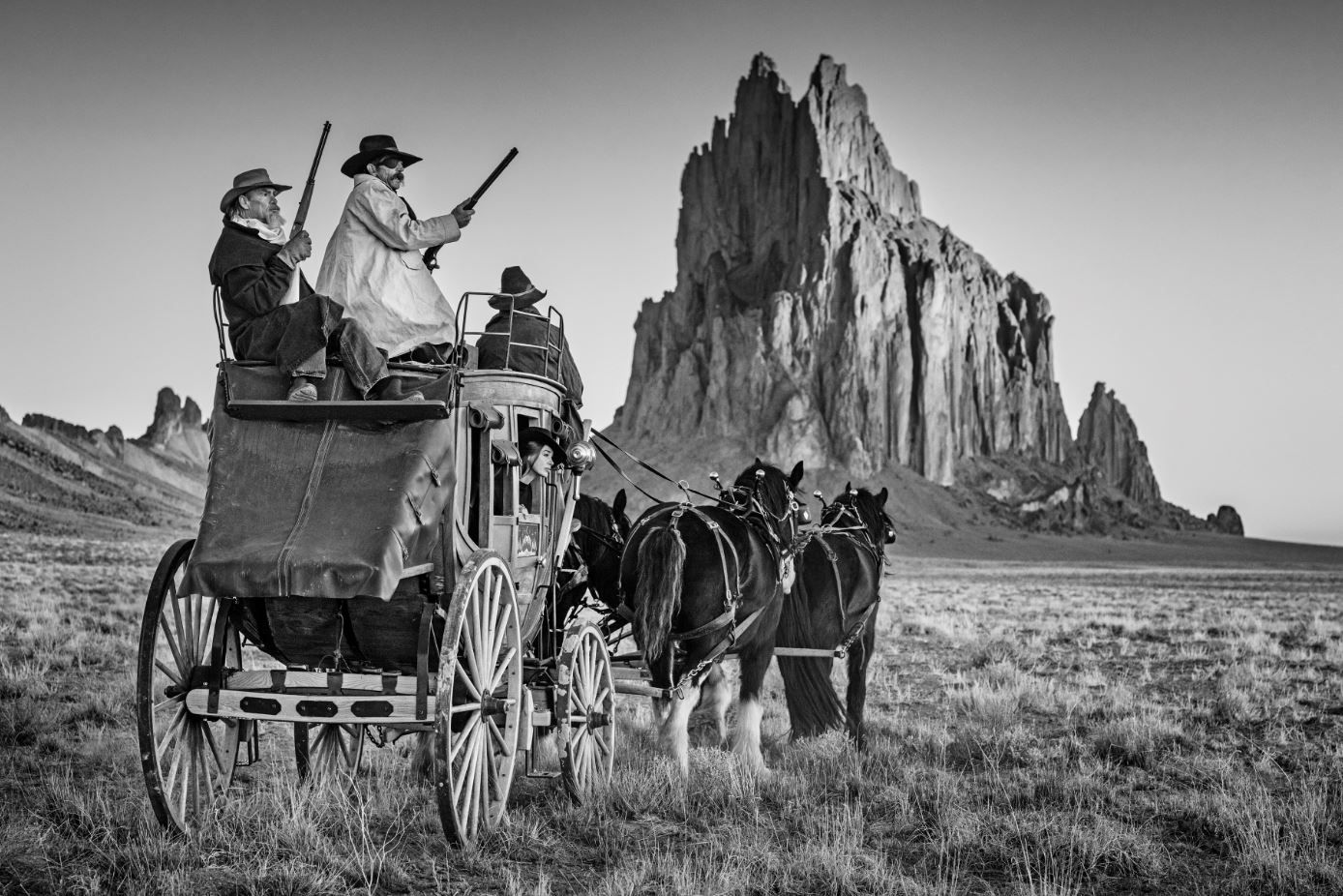
BETWEEN A ROCK AND A HARD PLACE
SHIPROCK, NEW MEXICO, USA – 2021
The majesty and grandeur of the American South West is without equal and has been a canvas for artists for over 100 years. Early Hollywood directors, such as John Ford, were known for framing their characters against the vast, harsh, and rugged natural terrain. Arguably the location scouting industry was born in the South West of America. Monument Valley in Arizona, where we have often filmed, is probably the flagship location. But 100 miles east of there, in New Mexico, lies Shiprock – a unique towering, bird-like volcanic rock formation that can be seen for miles in all directions. It rises vertically nearly 1,600 feet above the high-desert plain of the Navajo and in my view is as impactful as any location in America. The first question though was how could we best make use of search a sight. We had to have a complementary narrative and we also had to play the light to our advantage. On a clear day at Shiprock, as we have learned from experience, the light becomes suboptimal as little as 15 minutes after sunrise; it is just too strong and Shiprock itself lights up like a bonfire. The best plan is to shoot almost exactly at sunrise, allowing enough light for the characters in the narrative to have detail and not so much direct light on the rock itself. It is a fine line to get right, but I think we finally achieved it. This image smells of the great push West and the crew did a fabulous job. It is always satisfying to warp a shoot long before most people are out of bed.
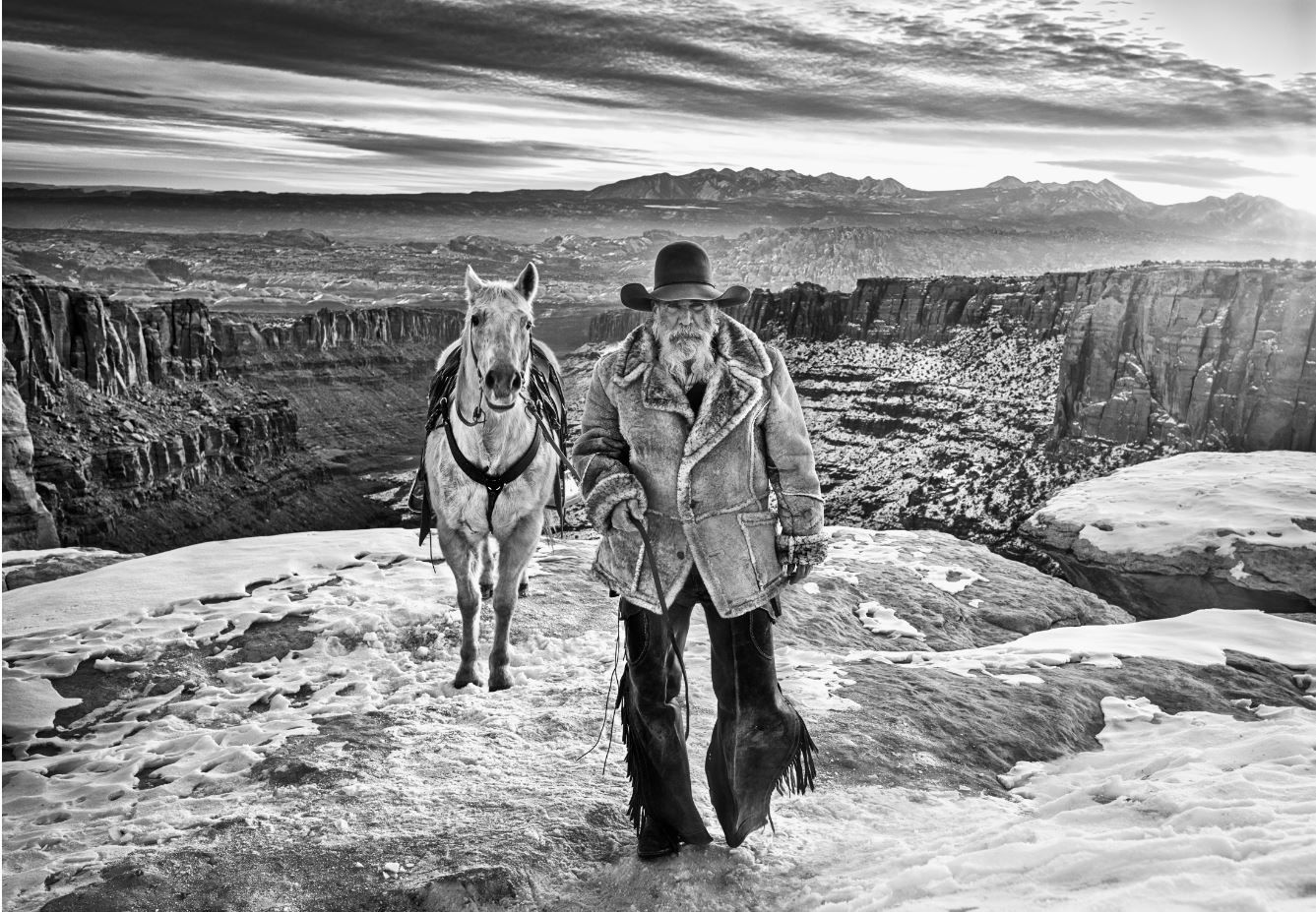
THE AMERICAN DREAM
CANYONLANDS, UTAH, USA – 2021
As my close friends, family and team know, I am my own biggest critic. I will not tolerate the bland or the mundane and we fail far more than we succeed. In my experience, it is primarily through failure that we eventually learn how to succeed. “Wild West” imagery is such a heavily populated genre that creatives run the risk of falling down a trope canyon no matter their earnest endeavor. It is challenging to transcend or be authentic. The legacy of Edward Curtis and Ansel Adams throws a heavy shadow over any contemporary photographer trying to pay homage to the American West. Filmmakers must feel the same when addressing John Ford’s ownership of the moving image. The grandeur and majesty of the final frontier may be without equal, but it has been so well documented that artists risk much by focusing on this heavily mythologized era. The excitement of just being there can impinge on creativity, a bit like a student of photography arriving in Paris for the first time. But this cinematic photograph allows for a fleeting moment of proud retrospection. The light and the compositional balance work and I can look at the print for some time – perhaps as much as any picture I have taken in the last couple of years. The image is as emotional as it is timely and relevant. It speaks to me and of course the cowboy is as good as it gets. America may have had the most challenging of years, but tomorrow a new chapter begins for a country that still leads the world in so many fields. Most of all, at its core, it remains a nation of entrepreneurs. Those that went west in the 1800s fought hard for everything they had and provided much of the foundation of the American Dream. Whether they were gold prospectors, picks and shovels suppliers or simply settlers, their collective fortitude shaped the America that we know and will soon love again. The cowboy capitalist was integral to the evolution of the American economy. Everything was possible and everything still remains possible. It would be remiss not to mention the Coen Brothers as an inspiration to me. For those that have not seen The Ballad of Buster Scruggs (Netflix), it is cinema at its very best and chapter four – starring the wonderful Tom Waits as the doggedly determined gold prospector – says more in 15 minutes about the American Dream than most Westerns achieve in two hours.
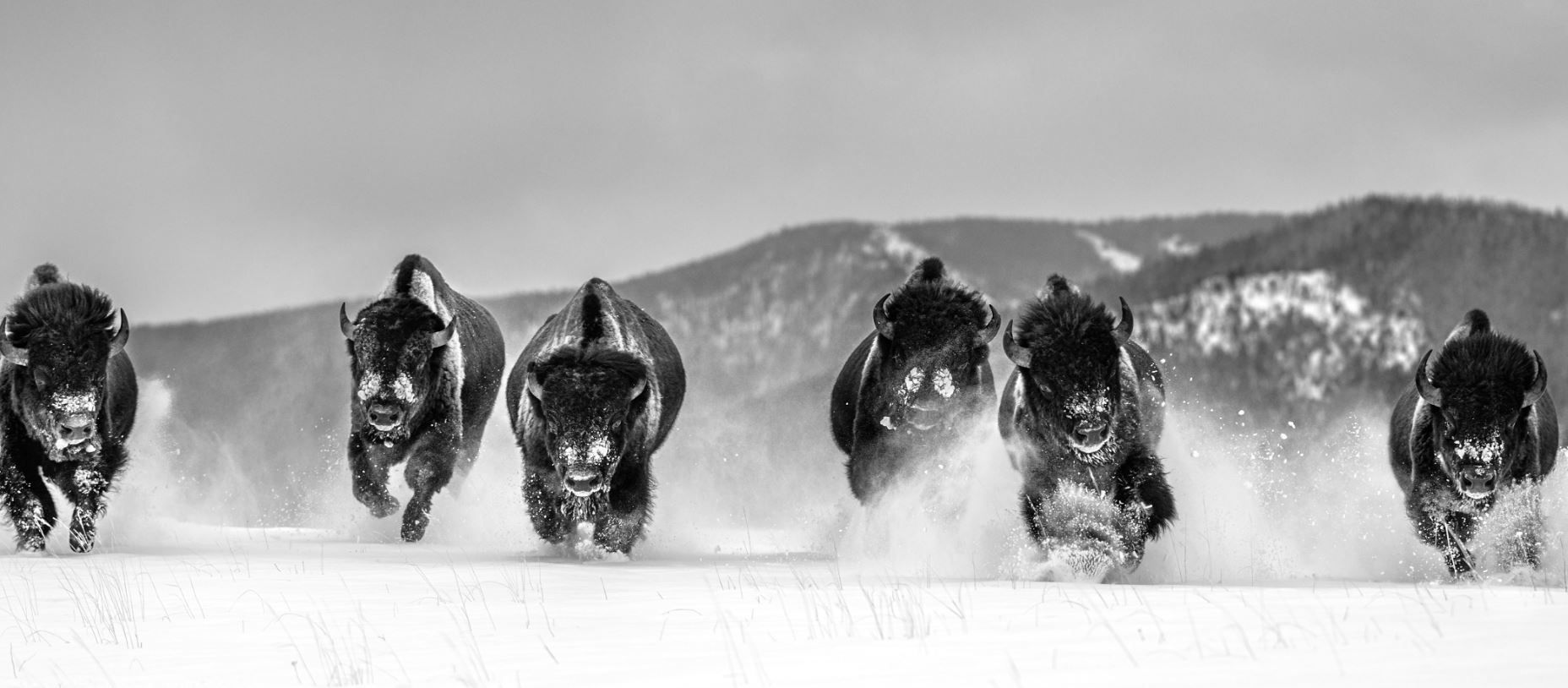
THE BILLS
THE FLYING D RANCH, SOUTHWEST MONTANA, USA – 2021
The concept of this photograph has been on my wish list for many years. A group of male bison charging through heavy snow, directly towards a camera is certainly a rare sight and it always seemed a bridge too far from almost every perspective. The question has always been where and how could this epic scene unfold in front of a camera? Yellowstone National Park was never going to be the answer. This sort of collective behaviour does not tend to happen in the park and if it did, there would be zero chance of being in the right place at the right time to film it. It is difficult to break new ground in Yellowstone. In 2020 an American artist, John Banovich, an exceptional talent and good friend, suggested that I approach Ted Turner to see if I could gain access to his stunning 180 square mile ranch – Flying D – saddling Yellowstone and neighboring Big Sky. This remarkable place is nine times the size of Manhattan and showcases Montana at its most stunning best. John’s wonderful painting of a group of running bison adorns the wall of the main reception of the exclusive Yellowstone Club and he took his inspiration from spending time at Ted Turner’s ranch. I recognized that this was a link worth pursuing. Flatteringly, a few months after my initial approach, the Turner team agreed to collaborate in the hope that we could raise money for Ted’s conservation initiatives. Ted Turner is one of America’s biggest landowners and also one of its most acclaimed conservationists and he reintroduced both bison and wolves into Flying D, one of his three Montana ranches. In mid-winter, his team of ranchers will herd some of the 5,000-resident bison into areas where feeding is easier and this controlled activity creates an opportunity to work a situation. Just like cowboys herding their cattle in Texas, the skill sets of the Turner ranchers in deep snow are a privilege to watch. The difficulty is that bison in this vast ranch are more skittish of humans on foot than their Yellowstone cousins, who see thousands of tourists every day. I therefore needed either to be camouflaged or out of sight as they made haste in my direction. Luckily the Flying D team knew of a group of rocks behind which I would be obscured from the bison’s line of sight. After many a failure, and some adjustments to the approach, one gorgeous winter morning in February, we achieved what we set out to do. It was a real team effort and I want to thank John Banovich and the whole Turner Corporation team at the Flying D.
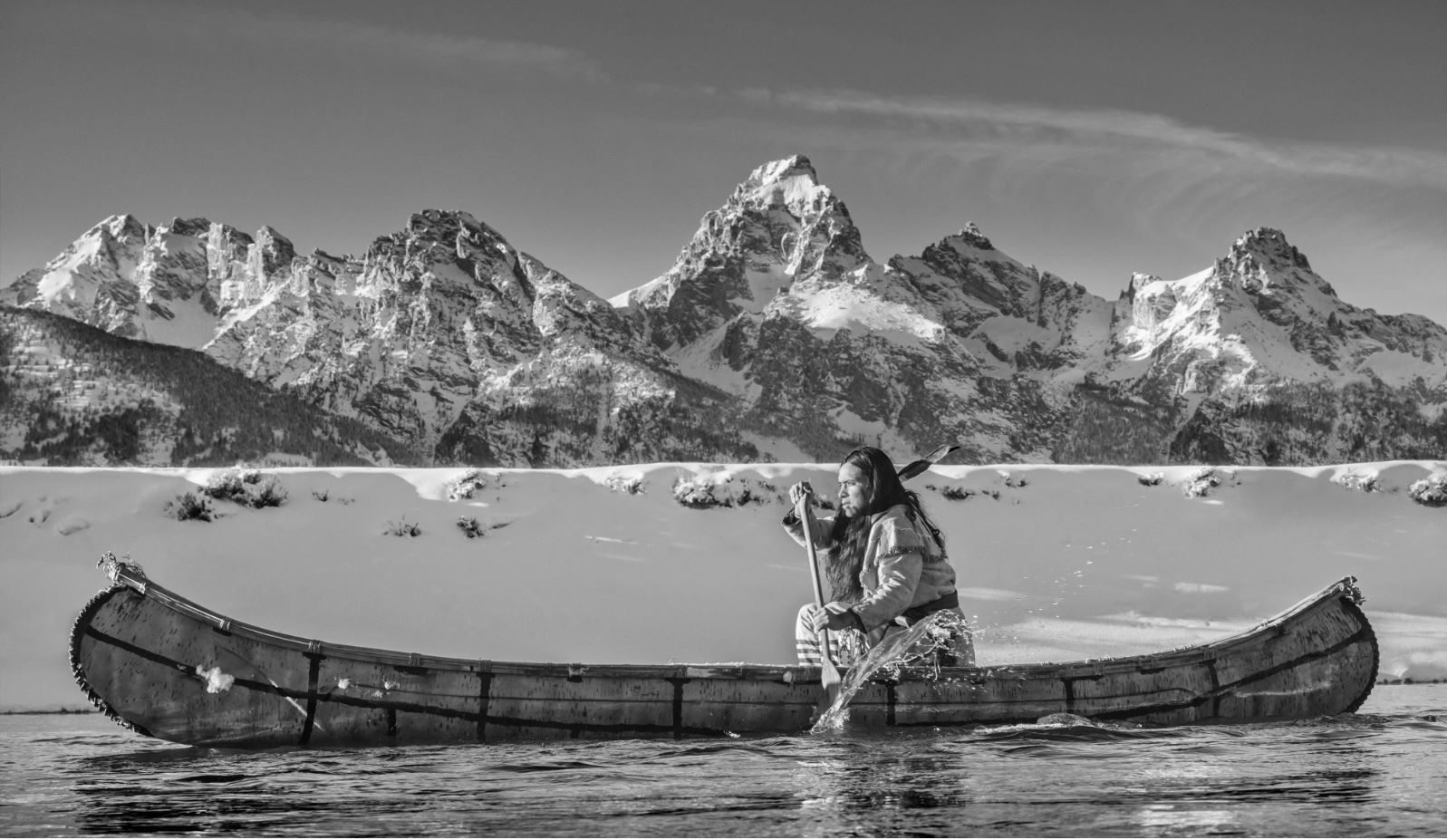
A RIVER RUNS THROUGH IT
GRAND TETON NATIONAL PARK, WYOMING, USA – 2021
Ansel Adams brought the majesty of Snake River and the Tetons into the homes of Americans in 1942. So there is no real commercial merit in a photographer traveling to this sensational destination in Wyoming and taking a loose landscape image on a tripod. They may take a beautiful image, but manifestly they would also be 79 years behind the curve. Teton National Park is an imperial amphitheater deserving not only our attention, but also our respect, and we are rather late in the game in documenting its magnificence. New images of the Eiffel Tower rarely make a Sotheby’s auction. My strategy in the Tetons was to play with what we had and be authentic in the additives. We threw around many ideas and then threw most out. The most authentic suggestion was the idea of working with a native American in a 19th century canoe on Snake River itself. The concept was sound, but the execution was hampered by the fact that the most scenic stretches of the river are three miles further east from the mountains than I would like. On a standard lens, the peaks lose some of their sense of enormity. But there is one stretch of water where the river runs parallel and much closer to the mountain base. The river banks are a little higher and block the base, but this was a small price to pay for the improved proximity between the canoe and the mountain range. In good light, this was always a late afternoon location, and the January temperature that day was low. I knew I was going to get wet and cold as the camera needed to be on the river’s surface and that meant me being deep in the river in normal ski clothing. The lower the camera, the more the mountains were amplified, and the canoe would also then be flat to my camera. The picture was all that mattered in those 10 minutes, not my comfort. Haatepah in the canoe was so game and did an extraordinary job.
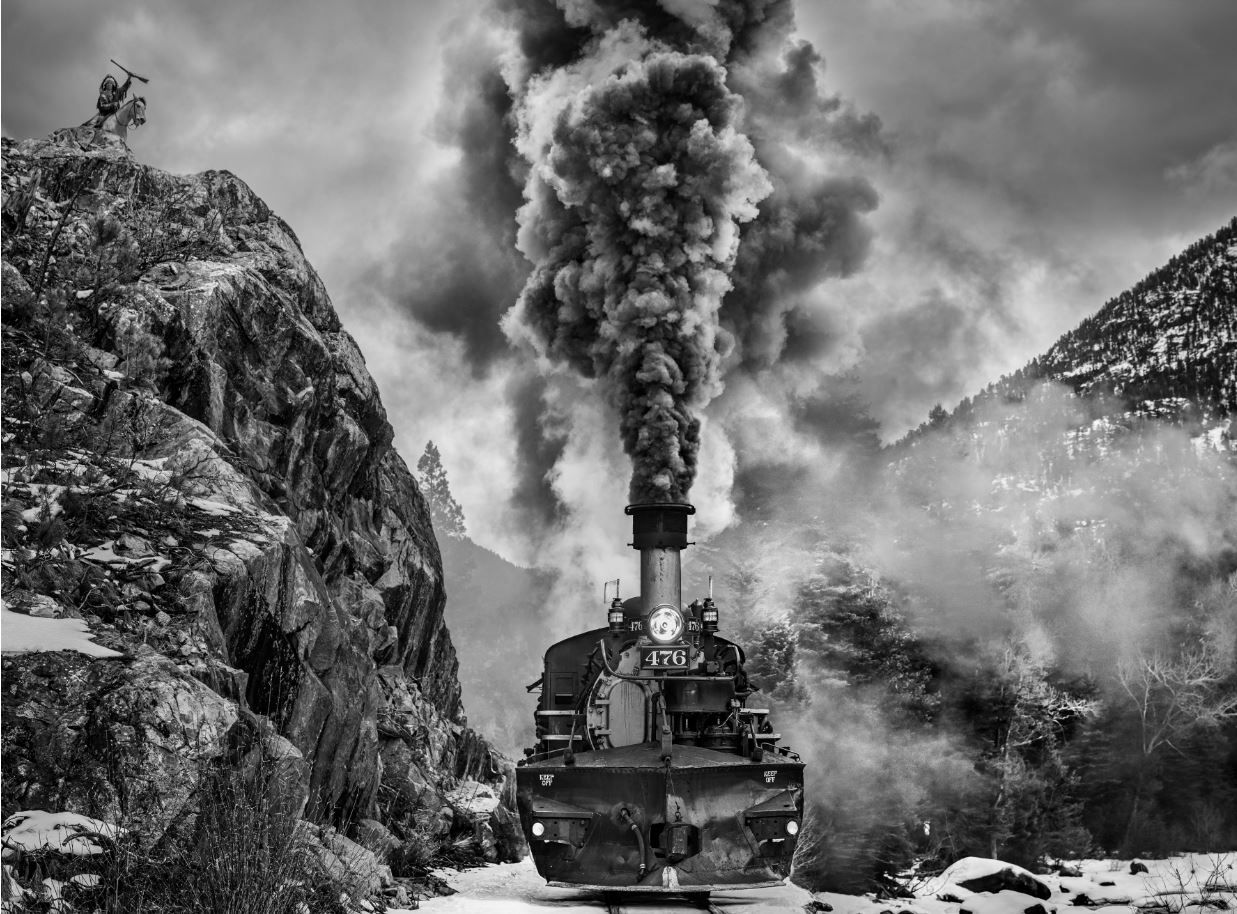
VANTAGE POINT
DURANGO, COLORADO, USA – 2021
In post Civil War America, some saw the railroad as a symbol of modernity and national progress. For others, however, the Transcontinental Railroad undermined the sovereignty of Native nations and threatened to destroy Indigenous communities and their cultures as the railroad expanded into territories inhabited solely by Native Americans. As part of my photographic anthology on the wild west, it was always my intent to bring Native Americans and a railroad together into an image, but I had no wish to objectify either party. A photograph for instance of a hostile railroad attack by a party of Native Americans could be labeled as stereotyping or indeed being blind to the provocation of what was effectively an invasion by American settlers, prospectors and capitalists. We entered this project to tell stories, not make overtly political points. After several scouting trips, I found an ideal location 10,000 feet above sea level on the track near Silverton, Colorado. The train owners told us that this section of the track had never been shot before and that sense of ground breaking always gives me a warm glow. The high cliff face offered a sense of a vantage point and the opportunity for the camera to tell a more passive observation story (albeit with a little attitude). The narrative seems entirely realistic as most of the time the natives would observe the Iron Horses from a safe distance with a mixture of fear; anger but also, I would imagine a hint of bewilderment. The driver of the steam train did a fabulous job with the flume – it was a magical sight to see.
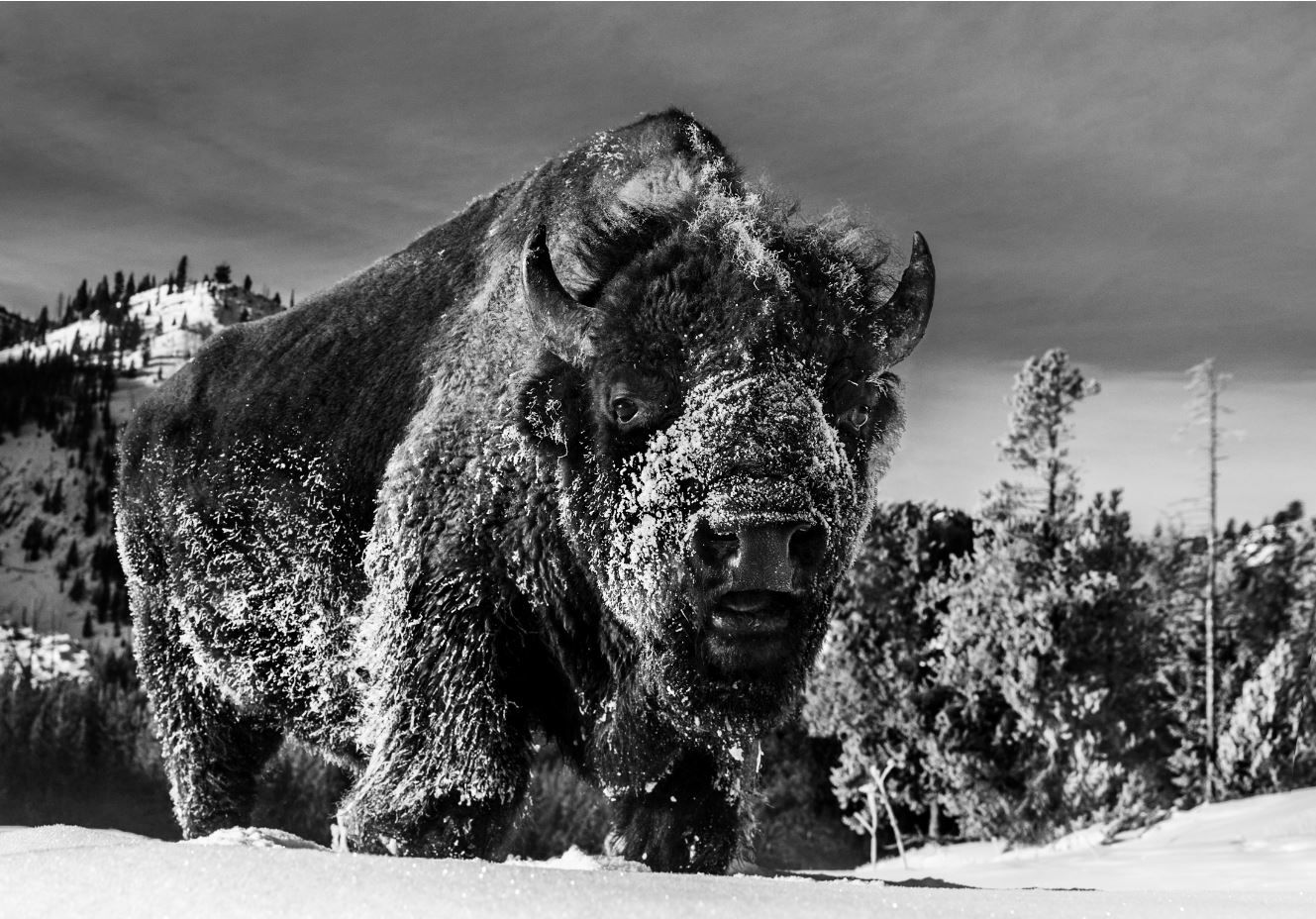
THE BEAST OF YELLOWSTONE
YELLOWSTONE NATIONAL PARK, WYOMING, USA – 2021
This is a beast of a bison. I will leave others to decide if it is a monster of a photograph, but it is as good as I can possibly do. His size, the mountain on the left, the snow laden forest on the right and the virginal snow in the foreground all coalesce in the most fortuitous manner. Meanwhile, the early morning sunlight allows for every detail on the bison’s face. This portrait was taken with a 35mm lens, the best portrait lens I know and this image is proof as to why. Setting the remote up was not that challenging as the massive bull was some distance from me at the time, but we then had to hope that we’d got both the maths and the bison’s direction of travel right. But this was down to luck more than judgment and this one image is perhaps the reward for the multiple of times we have failed. It is moments like these that offer the reason for using remotes, rather than just playing it simple and working with a telephoto. To me this photograph just shouts “Yellowstone”, America’s oldest National Park and one that in winter is an artist’s dream. There is simply no place like it on earth. It’s a very difficult image to replicate and I hope it will stand the test of time.
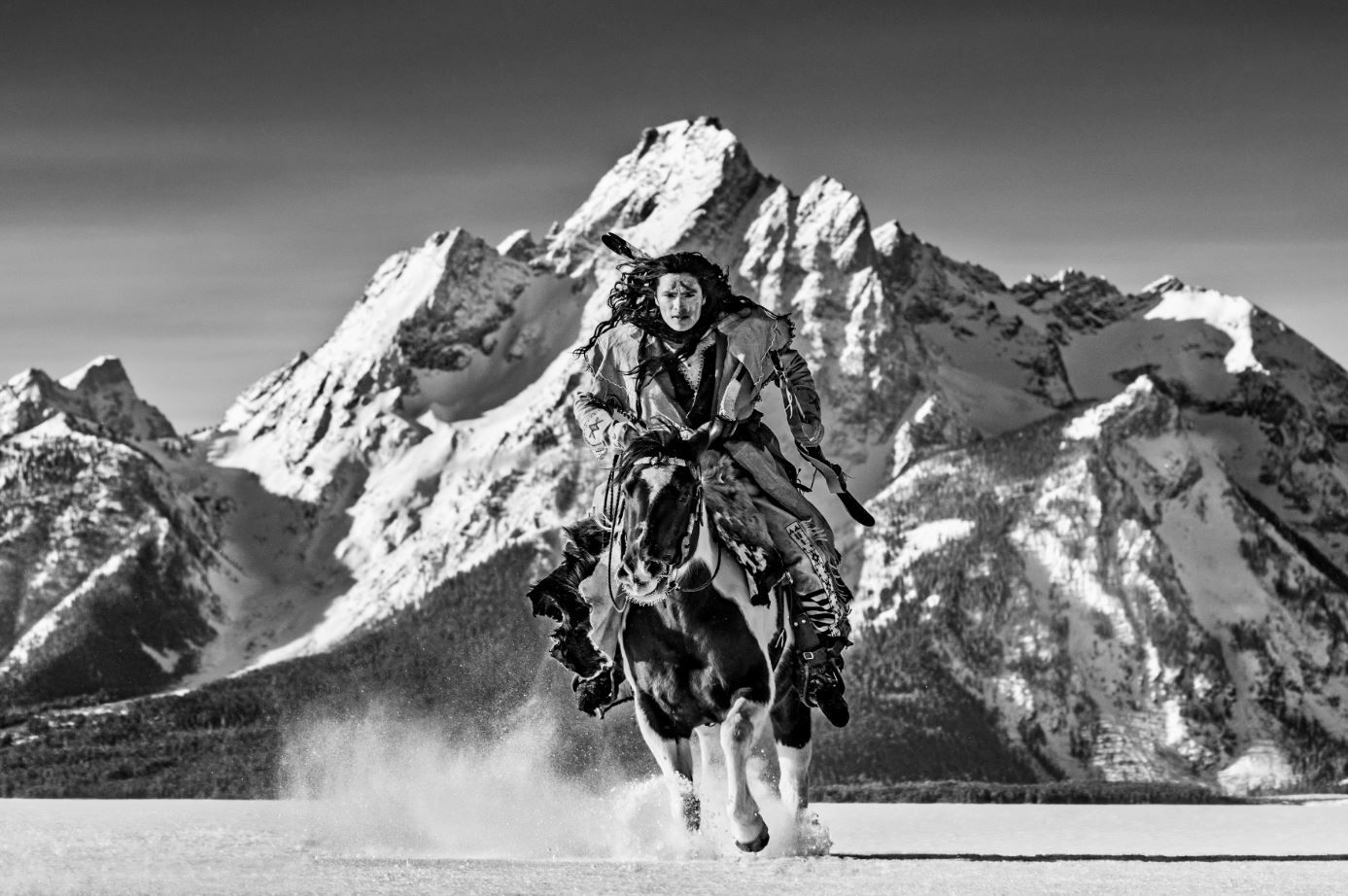
HIGH NOON
GRAND TETON NATIONAL PARK, WYOMING, USA – 2021
Mount Moran in the Tetons offers as good a mountain backdrop as I know in America. In the winter, in particular, it has a grandeur that is difficult to match. The lake below this section of the Tetons is frozen thick in mid-winter and offers the perfect stage on which to tell stories, but we are always mindful that on a good day, the whole scene becomes too bright within 45 minutes of sunrise. Images like this require very early starts and we are always in position well before dawn. The Native Americans were introduced to horses by early Spanish immigrants and they adapted quickly to the optionality and mobility given to them by horses. The Comanche in the south became a feared and dominant tribe largely because of their horsemanship skills. This frame – taken on a very cold morning in Wyoming – simply pays homage to a tested partnership that played a material role in shaping 19th-century American history.
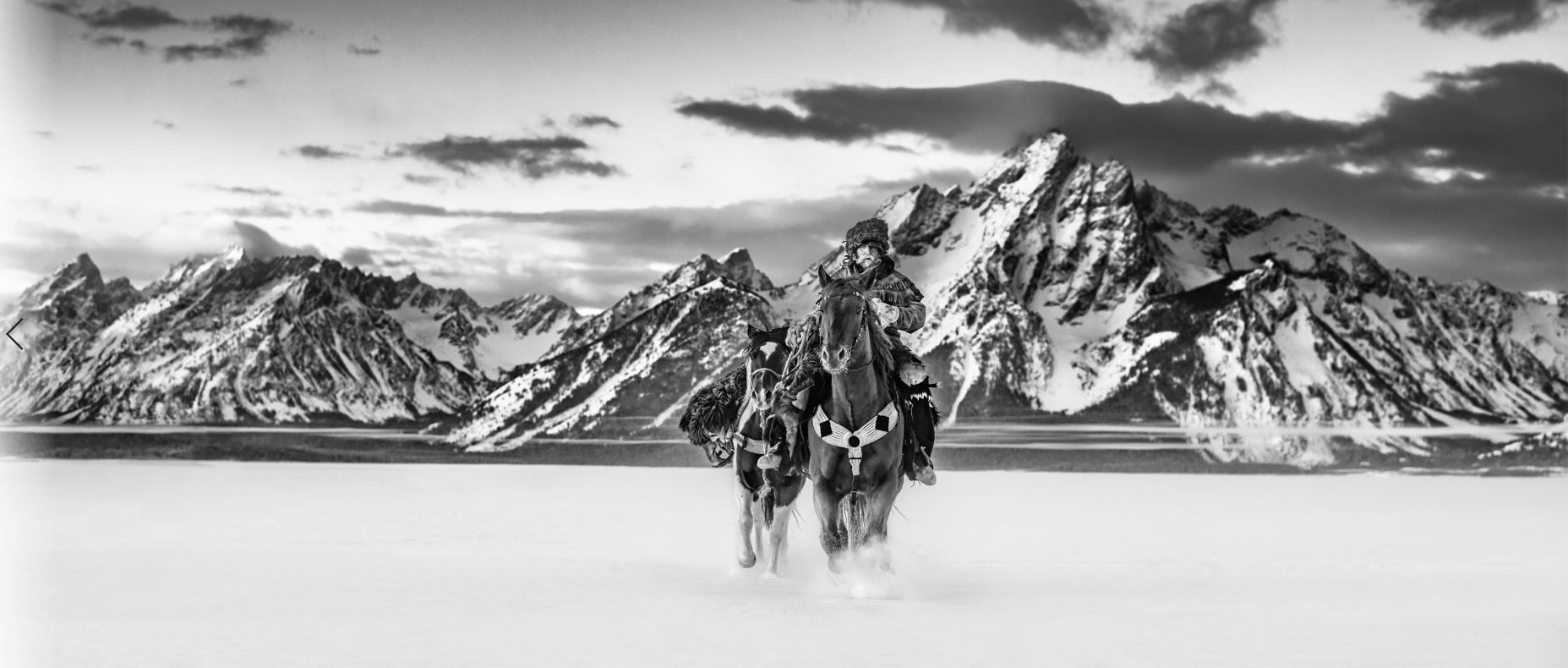
Wyoming
GRAND TETON NATIONAL PARK, WYOMING, USA – 2021
The Teton Mountains in Wyoming have stature all year round, but on a cold, clear, winter morning looking west, I would contend they offer as impressive a backdrop for a filmmaker as any mountain range in the world. The key to their drama is their almost vertical rise from Snake River and the lake below. There is nothing pedestrian or pastoral about their ascendancy to the sky. Julie Andrews would have struggled to sing and nanny seven children on these slopes, in fact there are not many slopes. The hills are more alive to the dangers of an avalanche than they are to the sound of music. This image was, however, made by the staged foreground narrative paying homage to the tough life of trappers. The dry lake offers a stage in winter, albeit an extremely cold stage. The morning we brought the horses onto the lake we were working in temperatures of around -26 degrees before sunrise. That is cold not only for me but also the camera, the cowboy and possibly even the horses. Riding on the frozen lake whilst leading another horse is only for a very skilled horseman and we had one in Randy Johnson – a veteran rodeo competitor and a rich character. This is a favorite image of mine and I think the lens choice and the time of the shot was right. 10 minutes later and the sun slams the mountains – at which point the balance of the picture would be lost.

